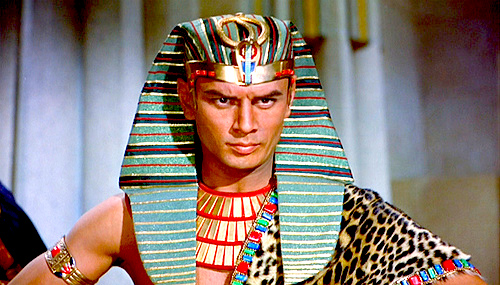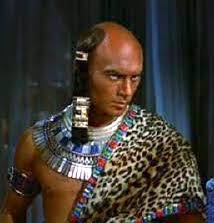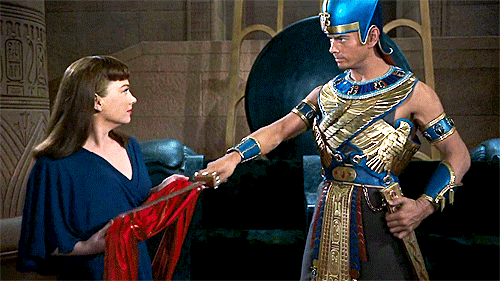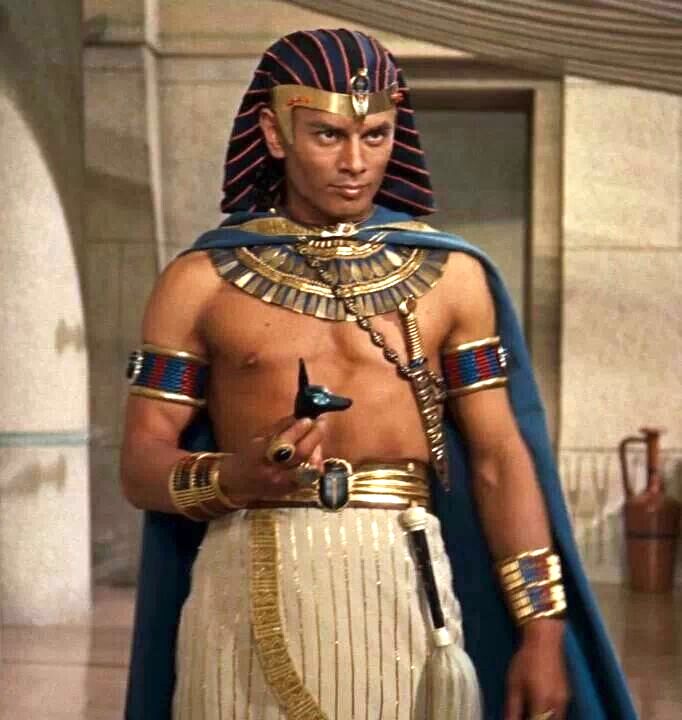by Eric Blume

Back in the day, Cecil B. DeMille’s epic The Ten Commandments received an annual Easter airing in network prime-time, much the way The Wizard of Oz and other family classics would be broadcast annually with much fanfare, delivering consistently high ratings each year (remember: only three network options!). I feel like I saw The10Cs multiple times when I was a little kid, each year mesmerized by its massive sweep, colossal size, and amazing special effects.
Revisiting the film for the first time as an adult, in honor of Yul Brynner’s Centennial, wowza is it a howler...
 It’s difficult to pick which element has aged the worst: the flimsy cardboard sets; the dime-store gold costumes; the amateurish acting by all the bit players; the bible-by-way-of-soap-opera dialogue…we could go on. Anne Baxter’s super-horned-up acting has truly got to be seen to be believed, but as terrible as she is, she does give the film a juiciness that it desperately needs. But in its defense, The10Cs still really does have a killer narrative drive and its own propulsive energy. It’s cheese, but it’s Roquefort.
It’s difficult to pick which element has aged the worst: the flimsy cardboard sets; the dime-store gold costumes; the amateurish acting by all the bit players; the bible-by-way-of-soap-opera dialogue…we could go on. Anne Baxter’s super-horned-up acting has truly got to be seen to be believed, but as terrible as she is, she does give the film a juiciness that it desperately needs. But in its defense, The10Cs still really does have a killer narrative drive and its own propulsive energy. It’s cheese, but it’s Roquefort.
Our boy Yul plays Rameses, who fights Charlton Heston’s Moses for the crown and for horny Anne Baxter. In the early part of the film, he wears a decorative side-single ponytail that he miraculously pulls off, and he has a lightness and command as a young Egyptian prince. As his character goes through levels of threat, he becomes less interesting, but Brynner has a quiet power in his more reflective scenes: he captures the sense of a man who knows his power is infinite, and who will chart a course to capture what is his. His Rameses always seems like the smartest person in the room.
Brynner’s “exotic” look, not a face audiences were accustomed to seeing on leads in Hollywood movies, and his clipped, metallic voice, make a perfect foil to Heston, at his leading-man-blue-eyed height. They’re a great match-up visually and stylistically: Heston’s old-school earnestness set against Brynner’s intoxicating eroticism.

The real thrill of Brynner’s performance here is its physicality. Brynner stands like a royal and walks like a royal. He places his body in an array of painterly poses throughout his scenes while remaining completely naturalistic. In the scene where he discovers that Moses is Hebrew, he holds a whip with what can only be called expertise, smartly using his prop as he thinks through his next steps. He uses his whole body with the grace of a ballet dancer and the intimidation of a fighter. He rocks all of his skirts, and he’s divinely sexy in costumes that would make a less confident actor look awfully silly.
1956 was Brynner’s big year. The King and I was released in June, The10Cs in November, and he followed it with Anastasia in December. In the DeMille picture, you get a sense that he knew he was coming into his own: he had the biggest supporting role in the biggest movie of the year, and he brought his natural authority and effortless intensity to this behemoth. Once he disappears from the film’s center, around the film’s midway point, The10Cs becomes a big of a slog: you miss Brynner, his edge, his legs, and his panache.

Related
• The Battle of Neretva
• Anne Baxter's Nefretiti
• More Yul